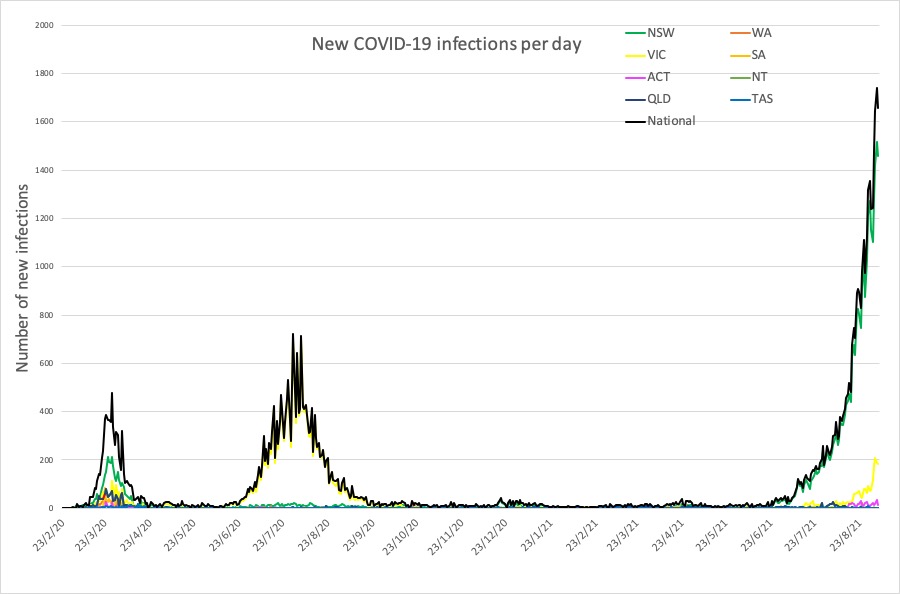And Australia's human biosecurity emergency period is extended to mid-December.
Welcome to The Medical Republic’s COVID Catch-Up.
It’s the day’s covid-19 news in one convenient post. Email bianca@biancanogrady.com with any tips, comments or feedback.
6 September
- Modern’s Spikevax gets provisional TGA approval for 12-17-year-olds.
- Federal government extends the human biosecurity emergency period to 17 December.
- Blood donor sample study in the US suggests true prevalence of covid was two to three times higher than reported.
- Rate of hospitalisation from covid ten times higher among unvaccinated than vaccinated adolescents.
- Two more deaths from rare clotting disorder linked to AZ vaccine.
- Latest covid infection numbers from around Australia.
Spikevax – the vaccine formerly known as the Moderna covid vaccine – now has provisional approval for use in 12-17-year-olds, the Therapeutic Goods Administration announced.
The approval comes just under a month after the vaccine was granted similar approval for those aged 18 years and over. As with adults, the vaccine will be given to children in two doses 28 days apart.
The provisional nature of the approval reflects a requirement to supply ongoing data from ongoing clinical trials and post-marketing surveillance.
The federal government has extended the human biosecurity emergency period to the 17 December 2021, granting them another three months to wield “powers to take any necessary measures to prevent and control COVID-19.”
Those powers include imposing restrictions on inbound and outbound travel to and from Australia, mandatory pre-departure covid testing and mask-wearing on international flights into the country, and restrictions on cruise vessels entering Australian territory.
The emergency powers have now been in place since 18 March 2020.
Around one in five adults in the US have infection-derived SARS-CoV-2 antibodies, according to a study of more than 1.5 million blood donation specimens which suggests the true rate of infection was two to three times higher than reported.
Writing in JAMA, researchers reported that the study found the rate of infection-acquired seropositivity – identified by the presence of antibodies to the SARS-CoV-2 ‘N’ protein, which is not included in vaccines – increased from 3.5% in July 2020 to 11.5% in December 2020, among blood donation samples taken from across all 50 states.
The covid vaccination campaign began on 14 December 2020, and by May 2020, the total seroprevalence of SARS-CoV-2 antibodies – both infection- and vaccine-acquired – increased to 83.3%.
The consistently highest rate of infection-induced seropositivity was among people aged 16-29 years, which increased from 5.5% in July 2020 to 27% in May 2021. In comparison, the infection-induced seropositivity rate among those aged 65 years or older was 1.3% in July 2020 and increased to 11.7% in May 2021.
The study also found that infection-induced seroprevalence rates were significantly higher among Hispanic and Black individuals, compared to other racial or ethnic groups.
Researchers said the findings suggest that the number of people infected with covid was actually just over three times higher than the official covid case numbers in July 2020, and just over two times higher than official case numbers in May 2021.
“Seroprevalence estimates indicate that the number of COVID-19 cases reported are fewer than the number of SARS-CoV-2 infections that have occurred, likely because many mildly symptomatic and asymptomatic individuals did not seek testing or clinical care,” they wrote.
The rate of hospitalisation among unvaccinated teenagers is around ten times higher than among vaccinated teenagers, data from the US suggests.
A study published in Morbidity and Mortality Weekly Report also finds that the overall hospitalisation rate from covid among children and adolescents has increased significantly since the emergence of the Delta variant in the US.
Researchers used data from a national covid-associated hospitalisation surveillance network to examine patterns in hospitalisations among those aged 0-17 years, from 1 March 2020 to 14 August 2021.
Over that time, the cumulative incidence of covid-associated hospitalisations among this age group was just under 50 per 100,000 children and adolescents. The weekly hospitalisation rate in 2021 reached its lowest level during June 2021, when fewer than 0.3 children or adolescents per 100,000 were hospitalised.
However this increased significantly in the weeks following, as the Delta variant spread, and the rate during the week ending 14 August was nearly five times higher than during the week ending 26 June. Among children aged 0-4 years it was nearly 10 times higher.
In the period from 20 June to 31 July 2021, 68 adolescents with known vaccination status were hospitalised with covid. Of those, 59 were unvaccinated and five were partially vaccinated, representing a 10-fold higher rate of hospitalisation among the unvaccinated compared to the vaccinated.
Two more Australians have died from the rare clotting disorder thrombosis with thrombocytopenia, attributed to the AstraZeneca covid vaccine.
According to the latest TGA vaccine safety update, there have now been 125 confirmed or probable cases of TTS linked to the AstraZeneca covid vaccine – resulting in eight deaths – with 9.6 million doses of the vaccine administered in Australia.
Here are the latest covid infection numbers from around Australia to 9pm Sunday:
National – 61,609 with 1039 deaths
ACT – 498 (15)
NSW – 33,782 (1459)
NT – 202 (0)
QLD – 1984 (0)
SA – 880 (0)
TAS – 235 (0)
VIC – 22,942 (183)
WA – 1086 (0)



